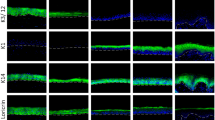Abstract
A haemolysis test has been evaluated as an alternative to the Draize eye test (Draize et al. 1944) for ocular irritancy. Haemolysis was seen with corrosive/ severe and severe/moderate eye irritants but was negligible with non-irritant substances.
Although not quite as sensitive as dog blood to irritants, human blood gave comparable results and was also more easily available in quantity. As with other in vitro tests, some false-positive results were given by the haemolysis test and also a few false-negative results. However, in all cases these were explicable given the physical and chemical properties of the materials. pH of test solutions did not seem to be a complicating factor.
There was good correlation between the results of this test and published in vivo data. Although it may not yet entirely replace the in vivo model, the haemolysis test is a valuable preliminary stage in a tiered approach to eye irritancy screening.
Similar content being viewed by others
References
Ballantyne B, Swanston DW (1972) Ocular irritation tests. Br J Pharmacol 46:577–578
Cripps CM (1968) Rapid method for the estimation of plasma haemoglobin levels. J Clin Pathol 21:110–112
Draize JH, Woodard G, Calvery HO (1944) Methods for the study of irritation and toxicity substances applied topically to the skin and mucous membranes. J Pharmacol Exp Ther 82:377–390
Harington JS, Miller K, Macnab G (1971) Haemolysis by asbestos. Environ Res 4:95–117
Harris LS, Kahanowicz Y, Shimmyo M (1975) Corneal anaesthesia induced by soaps and surfactants, lack of correlation in rabbits and humans. Opthalmologica 170:320–325
Kaufman HE, Shuster J (1974) If I can't measure it, what do I do with it? Invest Ophthalmol 13:412–413
Kay JH, Calandra JC (1962) Interpretation of eye irritation tests. J Soc Cosmet Chem 13:281–289
Lewis RW, McCall JC, Botham PA (1933) A comparison of two cytotoxicity tests for predicting the ocular irritancy of surfactants. Toxic in vitro 7:155–158
Potts AM (1991) Toxic responses of the eye. In: Amdur MO, Doull J, Klaassen CD (eds) Casarett and Doull's toxicology: The basic science of poisons. Pergamon Press, Oxford, pp 521–562
van Abbé NY (1973) Eye irritation: studies relating to responses in man and laboratory animals. J Soc Cosmet Chem 24:685–692
Weil CS, Scala RA (1971) Study of intra- and interlaboratory variability in the results of rabbit eye and skin irritation tests. Toxicol Appl Pharmacol 19:276–360
Weltman AS, Sparber SB, Jurtshuk T (1965) Comparative evaluation and the influence of various factors on eye irritation scores. Toxicol Appl Pharmacol 7:308–319.
Author information
Authors and Affiliations
Rights and permissions
About this article
Cite this article
Singleton, B.K., Libretto, S.E., Sibley, P.R. et al. An in vitro haemolysis test as an alternative to the draize test for ocular irritation. Comp Haematol Int 4, 49–54 (1994). https://doi.org/10.1007/BF00368267
Issue Date:
DOI: https://doi.org/10.1007/BF00368267




